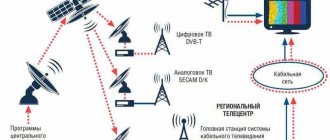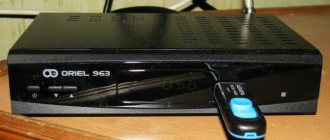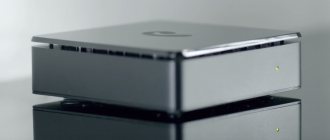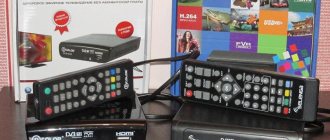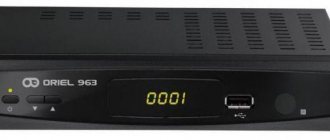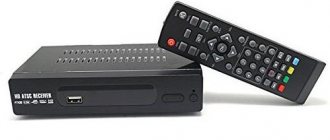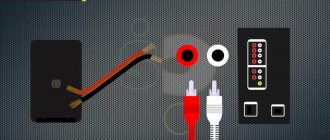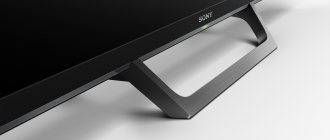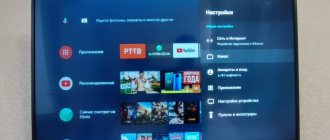Television is constantly evolving. At the moment, many different standards have been created for the convenience of users. One of the most popular is the DVB-C format. What's that on TV?
The main TV standards are as follows:
- DVB is a digital television format that is the main one in Europe;
- ISDB – distributed in Japan;
- ATSC – in America;
- DVB-C is the main cable television standard.
DVB-C standard
You may be interested in: Overhead projector “Firefly”: reviews, cartridges, manufacturer
What's that on TV? To start working with this standard, you need to insert a card issued by your provider into a special slot on the tuner. This format is based on encoding a changing image, and it also has audio in MPEG-2 format. The DVB-C receiver only works with a cable connection. In other words, you need to call a technician to install the cable. The need for its presence is one of the most important disadvantages of this type of standard, because it is impossible to install a cable in some houses, which means that it is not possible to use the DVB-C television standard. What is this on TV, how does it differ from other standards?
You will be interested in:DVR: what is it, description, device, functions and capabilities, reviews
MPEG-2 encapsulation
You may be interested in: DIY TV: ideas and options, step-by-step instructions
The DVB project has not defined its own image encoding algorithm, but has chosen a profile (subset) of the international standard ISO/IEC 13818, commonly referred to as MPEG-2 in ETR 154. MPEG-2 is an audio/video compression algorithm optimized for broadcast quality up to the HDTV standard based on discrete cosine transform and motion estimation. For the DVB project, they chose the MPEG-2 core profile at the base layer with a maximum data rate of 15 Mbit/s.
Main level means that up to 720x567 pixels at 25 Hz (TV frequency standard used in Europe) or up to 720x480 pixels at 30 Hz (used in North America) aspect ratios are supported:
- 4:3.
- 16:9.
- 2,21:1.
Basic profile means bidirectional MPEG frames are supported, but no SNR or resolution scalability is used.
ETR 154 has selected certain parameters that must be supported by all DVB receivers.
Video:
- Frame rate is 25 Hz in film mode and field frequency is 50 Hz in video camera mode.
- Aspect ratios 4:3 and 16:9 (2.21:1 optional).
- Receivers must support panning vectors that allow the most relevant portion of a 16:9 image to be displayed on a 4:3 display at the correct aspect ratio.
- Brightness image resolution: 720 x 576, 544 x 567, 480 x 576, 352 x 576,352 x 288.
The MPEG-2 standard also defines the ISO/IEC13818-1 multiplexing system, which allows multiple video and audio streams to be combined into one. DVB uses this multiplexing method to allow many different programs to be implemented with 38 Mbit/s bandwidth.
Modern television technologies
Many modern devices designed for television broadcasting have built-in support for DVB-C. What's that on TV? In this case, devices mean not only televisions, but also various receivers, set-top boxes and tuners. There are several reasons for this:
- most devices connect to cable broadcasting without any problems;
- there are many different options for DVB-C connectivity;
- connection cost is relatively inexpensive;
- easy to improve the quality of the resulting image;
- It's easy to provide your TV with mpeg support.
Modern set-top boxes mostly support DVB-C, because it is much easier and more profitable for the provider to set up this type of broadcasting.
Due to this, the demand for equipment with DVB-C support is growing. The manufacturer seeks to gain the favor of consumers by providing them with the opportunity to purchase equipment that supports DVB-C and mpeg4.
You may be interested in: How to assemble a socket: step-by-step examples and installation rules
In cities, DVB-C is the most popular. This is due to the fact that connecting cable television is inexpensive, does not take much time, and in most cases can be connected by the same provider that provides the user with the Internet.
How to connect DVB-C
If you have a modern TV, then most likely it already has built-in DVB-C support and a CAM module. Then all you have to do is purchase the module and access card from the provider, and then connect everything to your device.
If your model does not support DVB-C, then you need to purchase a tuner with this technology. There are a lot of them at the moment, so searching won’t take you much time.
If you have a DVB-C receiver for cable television and a special card reader, you can use this type of broadcasting even from your personal computer. All you have to do is pay for a subscription, which is reasonable considering the number of channels you get in return.
DVB-C technology is of interest primarily to users who already have cable television at their disposal, but only in analog format. In this case, you will not need to call a technician for installation.
Many providers provide large discounts on connecting to this type of broadcasting, because the procedure does not require any special costs, and the technology itself is extremely in demand among consumers. If you already have cable TV, then you should talk to your operator about signing up for DVB-C digital plans.
You may be interested in: How does a car DVR work? How the DVR works
Many modern LED TVs with DVB-C T2 have special connectors that greatly simplify the procedure for connecting the format due to the fact that the cable can be connected directly to the device without using additional tuners and set-top boxes.
When you connect the cable to the TV, all that remains is to set up the broadcast, and this is a very simple and quick procedure.
On average, when you connect to TV broadcasting in DVB-C format, you get more than a hundred different channels, among which everyone will find something interesting for themselves. Devices can increase the amount of resources provided when retuning broadcasts to other frequencies, but this is only possible with the permission of the provider, because it controls the content provided to users.
How to connect them?
If you have already activated the DVB-C tuner for your TV and completed all other settings, you can start searching for channels. To do this, you need to open the menu and find the “Channel setup” function. The name of the option may differ for different TV models.
Next is the menu item “Search for channels”, followed by “Automatic search”. Run an automatic channel search and the device will find all available in your region. That's how easy it is to connect and set up digital television and enjoy watching your favorite movies and TV shows.
What do the reviews say?
The DVB-C digital cable television format provides high quality picture and sound. It is more robust and less susceptible to interference than analog. Also a big advantage is the availability of connectivity. The main condition is the presence in your home of a provider providing cable television and Internet and cable services.
Digital signal transmission via cable has a number of advantages over satellite - no “snow”, noise or crackling. And the standards for encoding and compressing video and audio data MPEG-2, MPEG-4 allow you to broadcast programs in HD and SD formats.
In order to get a high-quality television product, you just need to contact your provider and connect to a digital data transmission service. Next, you should install and connect the DVB TV tuner. Reviews say that all channels work well and smoothly.
It is also possible to watch digital television on your personal computer. To do this, you need a DVB-C tuner and a card reader for a conditional access card. Unfortunately, the option of digital television with a DVB-C tuner is not available to owners of television antennas.
For regular resolution television, the data transfer rate is no more than 15 Mbit, and for digital format it is several times more - from 60 to 80 Mbit per second. If you look at all the DVB-C digital cable receivers in most stores with prices and reviews about them, this technology seems even more attractive. The cost of such devices starts from a thousand rubles, and the capabilities offered are very impressive.
Nuances and mechanism for transmitting digital images over fiber optic cables
The development of cable television immediately revealed a number of problems that needed to be solved to improve technology and improve quality. These problems consisted of the following nuances:
- Digital image induction noise ratio . The encoding depends on the quality of the optical fiber. If low quality or non-standard design wire was used when wiring the television, the noise level will be high. This means distortion in the image.
Important! The encoder setup was not done properly when developing digital television transmission systems. Image calibration has not been performed. An inverted or darkened picture appeared on the receivers. This is caused by an incorrect balance of noise and induction.
- Initially, coaxial cables were used for transmission. Multichannel lines are capable of transmitting information in digital format, but in a small volume. To supply an average city with a population of 250 thousand people, you will need a whole web of coaxial cable. It was replaced by optical fiber, which has a central supply, an encoder and 1-2 branches for each region.
- Batch errors occurred during broadcasting. They were excluded by special devices of an noise-resistant code developed according to Shannon's theorem: the ratio of the attenuation of interference to the amount of induction noise when transmitting one BIT of information over a solid conductor.
Differences between DVB-T and DVB-C
The differences between the different types of DVB standard have already been discussed above. If you don't have access to a cable, you can use a DVB-S connection. Moreover, today modern LG TVs with DVB-C S2 are available for sale. But can it be compared to the digital format?
The DVB-T standard guarantees high-quality signal reception. It is capable of not perceiving reflected signals. To increase resistance to various interferences, channel coding is used. This standard carries out exactly the same broadcasting as in the case of analogue television, but the transmission format and technology used are different. Terrestrial DVB-T broadcasting is completely different from satellite DVB-S or cable DVB-C. Decoders have completely different frequency channels and modulation methods, so they are not compatible with each other.
Digital TV is broadcast in the decimeter spectrum. Consequently, the quality of signal reception is affected by such indicators as: the terrain of the territory, the openness of the area to the transmitter and the compactness of the building.
What are the advantages of digital TV:
- High quality video, can be viewed on a large screen.
- Excellent sound quality.
- Huge selection of channels.
- Connecting parental controls.
Installation of fiber optic networks
Unlike outdated coaxial wires, fiber optic lines use alternative methods of transmitting the generated signal.
The wire itself is a collection of thin polymerized glass filaments. An encoder and decoder are mounted at the input and output of the cable. A frequency light signal in the laser spectrum is supplied to the beginning.
The encoder decomposes it into spectra with a decimeter wavelength and feeds it onto the polymer threads of the cable structure. The laser beam is reflected many times and is instantly transmitted to the end of the cable, where it enters the decoder.
The decoder collects the spectrum into one, calculates the changing images and transmits them to the receiving device of the television screen.
The first cable models were extremely unstable to bending, tensile loads, and mechanical stress. The slightest impact could damage the structure of the polymer threads.
Currently, the design has been modified and all the disadvantages have been eliminated. The technology has not lost its innovation and is actively developing.
Unlike coaxial cables, they have the following advantages:
- Instant transfer speed.
- Multifunctionality. One cable is capable of broadcasting a TV signal and the Internet.
- Easy to install.
- The cable structure implies the laying of backup lines, to which an automatic transition occurs in the event of damage to the main ones.
- Easy restructuring. The wire can be used for laying satellite TV. Only the source of supply at the beginning changes.
